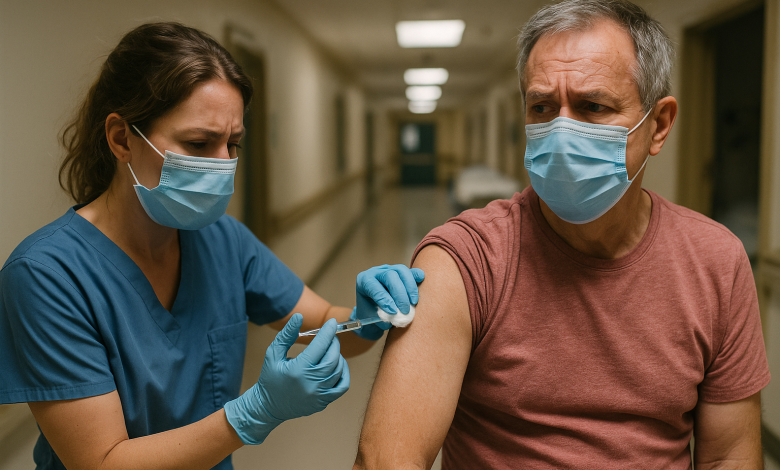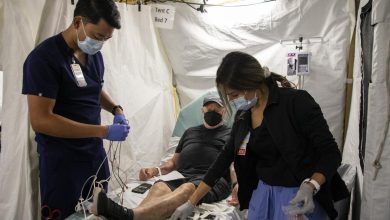Alberta’s COVID Vaccine Rollout Sparks Fears of Increased Hospital Admissions

In the vast, sweeping landscapes of Alberta, Canada, a quiet crisis is unfolding. Amid optimism about the ongoing COVID-19 immunisation efforts, many Albertans are waking up to an unsettling question: could the very vaccine rollout designed to protect us also signal an increase in hospital admissions? The emotional undercurrent of the community, and what it means for individuals, families and the broader public health landscape.
The Promise of Protection – and Why Some Feel Uneasy
It’s been more than a few years since the pandemic first shifted the world. In Alberta, the provincial government reaffirms that immunisation remains the cornerstone of protection. On their official portal, the Government of Alberta states: “COVID-19 immunization can protect and promote the health of Albertans and protect you from getting severely sick from COVID-19 infection.”
That promise is powerful. It gives hope to grandparents, parents with young children, and people with underlying health issues. But paradoxically, that same sense of hope is tinted with worry. Why? Because many Albertans are now facing hurdles: long appointment delays, confusion about eligibility, and a sense that hospital wards could soon fill again. One recent report noted that “Some Albertans struggled to book COVID-19 shots as the province’s fall immunization campaign opened to the general public.”
When the gateway to protection feels clogged, anxiety loops in. When hospitals once again become a topic of concern, tension replaces relief.
Why Hospital Admissions Are Triggering Alarm Bells
Let’s unpack the core of the issue. It’s not simply vaccines or no vaccines—it’s about what lies ahead in hospital admissions, and how the rollout is tied into that.
- Delayed or bottlenecked rollout – If vaccines are slow to reach large swathes of the population, there is a window in which infections can spread, complications rise, and hospital beds become scarce.
- Lower uptake in vulnerable groups – Vulnerable populations (elderly, immunocompromised) remain at risk if not adequately immunised or boosted. The official data show that vaccine coverage among older age groups in Alberta for the 2025-26 season is still small: e.g., the 65+ age group is at 7.3% coverage according to the most recent data.
- Seasonal pressures and respiratory viruses – Alberta’s own dashboard warns that “Circulation of respiratory viruses is normally highest in the fall and winter.” Combine a moderate COVID-19 wave with other respiratory illnesses, and hospitals can be overwhelmed.
- Public fatigue and hesitation – The more the public has made sacrifices, the more uncertain they become. Misinformation and mixed messaging add to reluctance or delay in getting vaccinated.
When these factors combine, it paints a scenario where increased hospital admissions are not just possible—they become a looming threat.
The Human Side: Stories That Hit Close to Home
Numbers matter—but human stories matter more when the stakes feel personal. Imagine a retiree in Calgary who has delayed their booster because of travel, work or simply waiting for the “right” clinic. Or a middle-aged parent who avoided earlier vaccination rounds and now watches news of hospital overload with growing dread.
It’s not just about fear—it’s about expectation, responsibility, regret. If the healthcare system becomes strained, it’s not just those with COVID who lose out—it’s those with broken bones, cancer surgeries, mental health crises. The ripple effect is vast.
Moreover, when people feel excluded or left behind (either by access issues or by unclear messaging), trust erodes. And when trust goes, even well-meant public health efforts suffer.
What’s Really Happening in Alberta’s Data?
Let’s peek at what the numbers tell us—bearing in mind they are imperfect and ever-changing.
- The respiratory virus dashboard for Alberta shows very low coverage for the 2025-26 COVID-19 vaccine campaign: total doses administered stand at 92,938 out of a population of about 4.9 million, or roughly 1.9% coverage at this writing.
- Alberta’s historical pandemic data show that hospitalizations surged when case counts rose, particularly during the so-called fourth wave.
- The fact that appointment booking frustrations are already emerging indicates implementation stresses.
While these numbers don’t directly prove that hospital admissions will spike because of the current rollout, they underscore the vulnerabilities: low uptake, seasonal pressure, and system stress.
The Emotional Landscape: Fear, Hope & Responsibility
Why do people respond emotionally to these developments? Because the stakes are not abstract. They involve life and livelihood.
- Fear: Fear of hospital stays, of loved ones suffering, of the painful scenario of “if I get sick and there’s no bed.”
- Hope: Hope in a vaccine, hope in a return to normalcy, hope in doing one’s part for family and community.
- Responsibility: Many feel a deep responsibility—to their children, to aging relatives, to the broader community. There’s a moral undertone: vaccinate not just for me, but for us.
- Guilt / regret: If someone delays or refuses vaccination, and then hears of hospital strain or worse outcomes, regret can set in—“Did I do my part?”
Public health messages and the rollout need to connect on this emotional level—not just on the technical one.
Where the Rollout Strategy Could Be Strengthened
If the goal is to avoid increased hospital admissions, the rollout must be sharp, thoughtful, inclusive. Here are key strategic pivots Alberta could focus on:
- Speed and ease of access – Ensure appointments are widely available, mobile clinics reach remote, rural, or underserved areas; reduce waiting times.
- Target the vulnerable and under-vaccinated – Focus on elderly, immunocompromised, and people in crowded residences. Clear communication and trust-building is essential.
- Transparent messaging – Explain clearly how the vaccine rollout ties into hospital capacity, explain the risks of non-vaccination, and manage expectations about potential hospital pressure.
- Combine with other respiratory measures – Since fall and winter bring other viruses, integrate COVID vaccination with influenza campaigns, respiratory health awareness, ventilation and mask guidance.
- Community engagement – Leverage local leaders, primary care providers, community groups to build trust; address misinformation proactively.
When implemented well, the rollout is not just a vaccine deployment—it becomes a community mobilization for health resilience.
Why You Should Care—and What You Can Do
Whether you live in Alberta, another province, or another country entirely, this topic matters. Here’s why—and what you can do.
Why you should care:
- Hospital capacity affects everyone—not just COVID patients. When hospitals are full, surgeries get delayed, emergencies get riskier, and stress rises for healthcare workers.
- Even if you’re vaccinated or young and healthy, your loved ones might not be. Community immunity matters.
- The ripple effect of a strained system touches economy, mental health, and civil life.
What you can do:
- Get vaccinated (if eligible), and keep boosters up to date. Every dose counts.
- Encourage others—family, friends, colleagues—to do the same. Share accurate info, not fear.
- Stay informed about local public health guidance—especially as seasons change and new variants or viruses may surge.
- Adopt preventative behaviours: good hygiene, ventilation, mask use when needed. These still matter.
- Consider what we owe to each other: community protection, solidarity, mutual care.
Your action matters.
A Look Ahead: What to Watch For
Here are the key signals to monitor in the coming weeks and months in Alberta:
- Hospital admission rates — Are they trending up in real time? Are they tied to new cases or worse outcomes?
- Vaccine rollout progress — What percentage of eligible populations are vaccinated, especially high-risk groups?
- Seasonal virus interplay — Are influenza, RSV or other respiratory viruses driving hospitalizations in concert with or separately from COVID?
- Public health messaging shifts — Is the government responding proactively with clear communication, or does access remain frustrating?
- Strain on health system resources — Are surgeries being postponed? Are ICU beds becoming scarce? Are health-care workers being over-burdened?
If the vaccine rollout falters or is too slow, those signals can turn into concern. If it accelerates, with strong uptake and clear strategy, hospital admissions can be kept in check.
Bringing It Home: Your Role as a Stakeholder
You might ask: “What does this have to do with me?” The answer is: everything. In a public health challenge like this, every individual is a stakeholder. Every decision, every vaccination, every preventive measure contributes.
You are not passive. You are part of the wave—either helping to calm it or fueling its climb. If you have children, elderly relatives, or vulnerable friends: you are their advocate. If you are healthy and under-vaccinated: you may be a hidden link in the chain. If you are already vaccinated and doing everything right: you’re part of the solution.
Your voice matters. Your choice matters. And the way you influence others—by example, by conversation, by support—matters too.
Concluding Thoughts: Cautious Hope in Uncertain Times
In Alberta’s vast horizon, where prairies stretch and skies are wide, there is room for both hope and concern. The vaccine rollout for COVID-19 carries promise—but that promise is not guaranteed unless we act quickly and together. The spectre of increased hospital admissions is real—not because of fear-mongering, but because of the credible scenario created by low coverage, seasonal risk and system strain.
But here is the message to carry: it is not too late. Rollout delays don’t mean failure; low uptake doesn’t mean defeat. With clear strategy, widespread engagement, and individual actions, we can steer toward protection, not overflow.
From the grandparents in Edmonton counting their children and grandchildren, to the young professionals in Calgary juggling work and health, to the rural communities of Northern Alberta—your decision matters. The vaccine is not a panacea, but it is a powerful tool. Use it. Encourage it. Make it part of your story.
Because when hospitals are full, the ripple reaches us all. And when they are not—because we acted—the ripple becomes our collective resilience.
This is your moment. Be part of the protection. Be part of the solution. Be part of Alberta’s story of hope, recovery—and strength.




